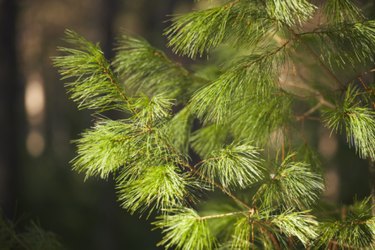
The pine tree genus (Pinus) contains approximately 115 species of evergreen conifers that are primarily native to northern parts of the United States. How long do pine trees live? Believe it or not, some can last more than 1,000 years, but their life can be cut short if they don't get enough water. Symptoms of an underwatered pine tree include brown needles, many needles dropping before the summer and early fall and large patches of peeling bark.
Varieties of Pine Trees
Video of the Day
Some of the most common species of North American pine are eastern white pine (Pinus strobus, USDA hardiness zones 3-9), western white pine (Pinus monticola, zone 3), sugar pine (Pinus lambertiana, zone 6), red pine (Pinus resinosa, zones 2-5) and pitch pine (Pinus rigida, zone 4). These trees and others like them have needles that grow in bundles of two to five. Those bundles are wrapped with paper-thin scales that attach to the twigs. Most last for about six months before dropping, with new ones growing in all the time.
Video of the Day
There are two kinds of cones: ones that produce pollen and others that develop and drop seeds. The latter kind is larger and attached to limbs on short stalks. Pine cones take about two years to mature, and once emptied, they can hang on for years or immediately drop off. Depending on your area, you may see them all over the place at certain times of the year.
Do Pine Trees Need Water?
Most pine tree varieties are drought-tolerant and don't need that much water to survive and thrive. In most climates, they get all that they need from the rain. You will need to water mature pine trees during dry winters or extreme drought. When these conditions are present, you'll need to saturate the soil once a week. To do this, give the trees 1 to 3 inches of water to quench their thirst and help the roots grow. You can add mulch around the base to help the soil retain moisture and prevent weeds.
When planting a pine tree into the ground, dig out the hole and fill it with water. Allow that to drain completely, place the tree inside, add the rest of the soil and water it again. For the first two or three weeks, you should water the new pine tree every day; then, you should decrease that to watering it every two to three days until it is 12 weeks old. Afterward, you can water it once a week until its roots are well established.
Signs of an Overwatered Pine Tree
Do pine trees need a lot of water? The general rule for watering established trees is 10 gallons for each inch of the trunk's diameter when needed. Experts like drip irrigation because it's slow and consistent with less water evaporation. In any case, you shouldn't have to worry about watering your pine tree unless the weather conditions require it and you see the symptoms of an underwatered pine tree.
The symptoms of overwatering can include significant needle drop, bald patches on the tree or browning that starts at the bottom and spreads up and out. These overwatering symptoms are not that common but could happen if your region experiences a lot of heavy rain. You should check the soil to see if it is soggy or flooded, and if it is, you can try aerating it or dethatching it. Remove as much mulch as you can to speed up the drying-out process.